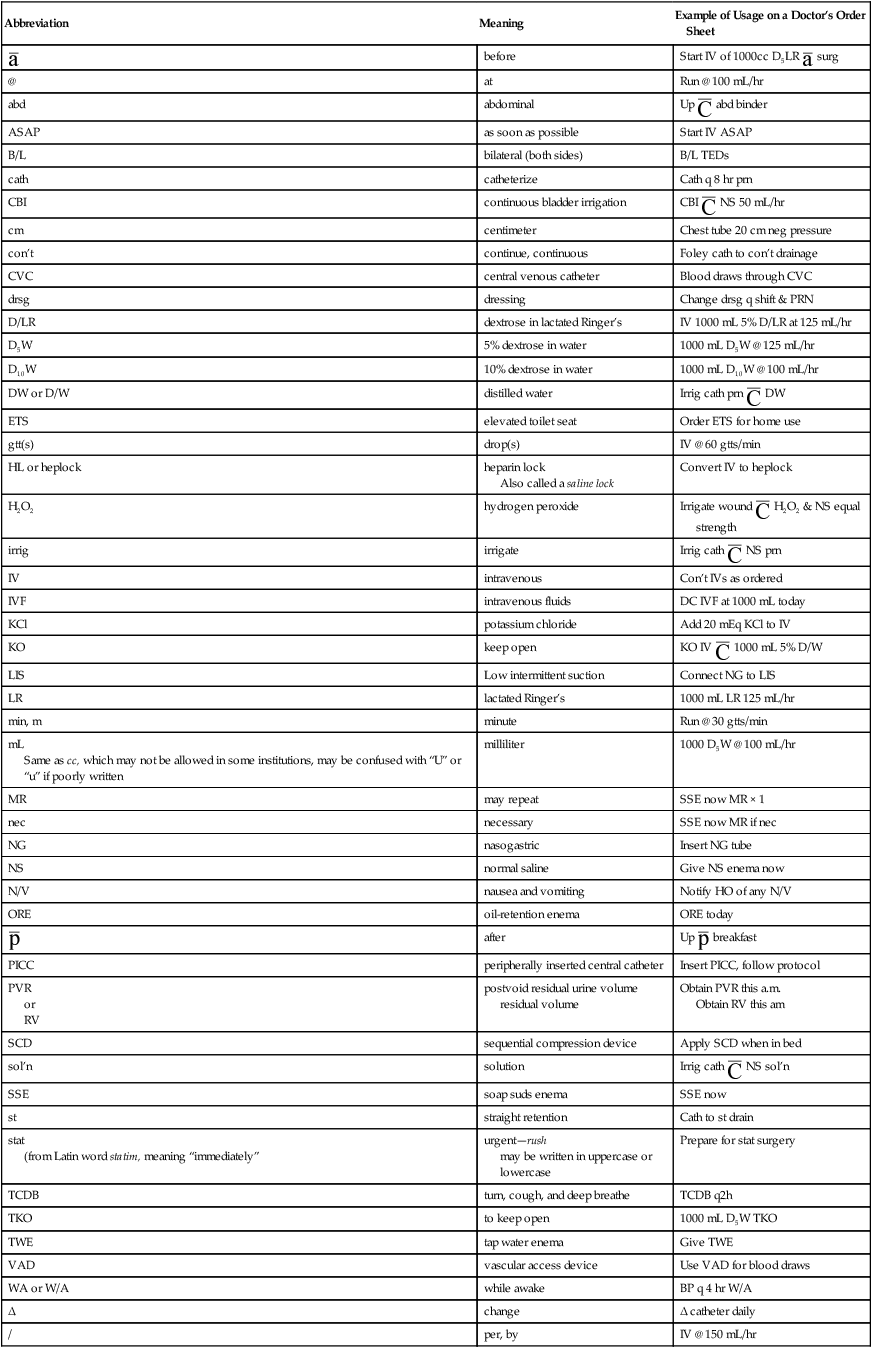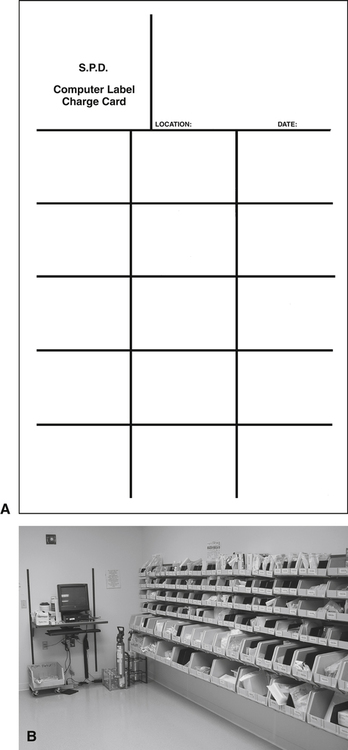On completion of this chapter, you will be able to: 1. Define the terms in the vocabulary list. 2. Write the meaning of the abbreviations in the abbreviations list. 3. Describe what is included in holistic care, and provide an example of a nursing intervention. 4. Describe the function of the central service department with regard to nursing treatment orders. 5. List the types of items stored in the central service stock supply closet (C-locker or cart) on the nursing units and the types of items stored in the central service department. 6. Explain why discontinued reusable equipment should be returned to the central service department as quickly as possible. 8. Explain the procedure and purpose of a urine flow test. 9. Explain two types of urinary catheterization procedures and two methods of measuring postvoid residual urine volume. 10. Describe two methods and four purposes of administering intravenous therapy. 11. Explain the major difference between peripheral intravenous therapy and a central line. 12. List four types of central venous catheters. 13. Explain the purpose of a heparin lock, and describe how a heparin lock is kept patent. 14. List three parts of a physician’s order for intravenous therapy. 15. Identify three commercially prepared intravenous solutions, and explain how the health unit coordinator (HUC) would determine how long a bag of intravenous solution would take to empty. 16. List the four blood types and explain the importance of correct labeling of a blood specimen that is being sent for a type and crossmatch. 17. Explain the HUC’s role in obtaining blood from the blood bank and the correct storage of blood. 18. Discuss the purposes of an arterial line and a Swan-Ganz catheter. 19. Identify three types of suction devices inserted during surgery. 20. List at least two heat applications and at least two applications used for cold therapy. 21. Explain why most comfort, safety, and healing orders require a doctor’s order, and identify at least five items or types of equipment these orders may include. 22. List at least four complementary or alternative approaches or therapies that may be recommended or provided to hospitalized patients. An absorbent garment worn by patients who are incontinent. Arterial Line (art-line or a-line) A cloth or elastic bandage that is usually used for abdominal or chest support. Insertion of a catheter into a body cavity or organ to inject or remove fluid. A disposable pad placed in areas where patients either lie or sit. Donor-Specific or Donor-Directed Blood Blood donated by relatives or friends of the patient to be used for transfusion as needed. The introduction of fluid and/or medication into the rectum and sigmoid colon. Used to remove gastric contents. Harris Flush or Return-Flow Enema A mild colonic irrigation that helps expel flatus. Inability of the body to control the elimination of urine and/or feces. Indwelling or Retention Catheter Intermittent (Straight) Catheter The administration of fluid through a vein. Washing or flushing out of a body cavity, organ, or wound. Intravenous (IV) Infusion Pump A device used to regulate the flow or rate of intravenous fluid; more commonly called an IV pump. Needleless Heplock or Saline Lock A safe, sharp device that is placed on a peripheral intravenous catheter when used intermittently. An infusion of a liquid prepared solution directly into a vein intermittently or continuously. Peripherally Inserted Central Catheters (PICC or PICs) Postvoid Residual Urine Volume The measurement of urine left in the bladder after urination. Devices used to control patients who exhibit dangerous behavior or to protect the patient. Application of warm water to the pelvic area. See Intermittent (Straight) Catheter. (Thrombo-embolic-deterrent) A brand name for antiembolism (AE) hose. A tube is placed in the body to drain and collect urine from the bladder. Urine that remains in the bladder after urination. a funnel-shaped device that reads, measures, and computes the rate and amount of urine flow. A nursing intervention is any act performed by a nurse that implements the nursing care plan or any specific objective of the clinical plan or pathway, such as turning a comatose patient to avoid the development of decubitus ulcers (bedsores), or teaching insulin injection technique to a diabetic patient before the time of discharge. Interventions may include support measures, activity limitations, administration of medications, or treatments given to relieve the current condition or to prevent the development of further stress. The emphasis is on a holistic approach in nursing care. Holistic nursing or comprehensive care consists of total patient care that considers the physical, emotional, social, economic, and spiritual needs of the patient; the patient’s response to illness; and the effects of the illness on the ability to meet self-care needs. Nursing interventions and treatment orders are discussed in this chapter. The process for obtaining central service supplies may vary among hospitals; thus it is impossible to outline one procedure that would cover all hospital systems. Disposable or frequently used items are stored on each nursing unit (items will vary depending on the specialty of the nursing unit). That storage space is often referred to as the CSD closet, CSD room, or C-locker. When paper charts are used, the charging process is done by removing a bar code label from the item and placing it on the patient’s CSD charge card. Figure 11-1, A, shows a CSD card. The person who removes the supplies is responsible for placing the bar code label on the patient’s CSD card. In hospitals using an electronic medical record (EMR) system, a computer with a scanner is located in the storage area and nurses may scan items with bar code labels directly into the appropriate patient’s EMR. Figure 11-1, B, shows a computer used for this purpose located in a CSD closet. Reusable or infrequently used items are stored in the CSD. Refer to Table 11-1 for a comparison of items commonly stored on nursing units and items often stored in the CSD (items in each category may vary among hospitals). TABLE 11-1 Items Obtained from the Central Service Department (CSD) IV, Intravenous ∗Certain IV solutions are obtained from the pharmacy in some hospitals.
Nursing Intervention or Treatment Orders
Abbreviation
Meaning
Example of Usage on a Doctor’s Order Sheet

before
Start IV of 1000cc D5LR  surg
surg
@
at
Run @ 100 mL/hr
abd
abdominal
Up  abd binder
abd binder
ASAP
as soon as possible
Start IV ASAP
B/L
bilateral (both sides)
B/L TEDs
cath
catheterize
Cath q 8 hr prn
CBI
continuous bladder irrigation
CBI  NS 50 mL/hr
NS 50 mL/hr
cm
centimeter
Chest tube 20 cm neg pressure
con’t
continue, continuous
Foley cath to con’t drainage
CVC
central venous catheter
Blood draws through CVC
drsg
dressing
Change drsg q shift & PRN
D/LR
dextrose in lactated Ringer’s
IV 1000 mL 5% D/LR at 125 mL/hr
D5W
5% dextrose in water
1000 mL D5W @ 125 mL/hr
D10W
10% dextrose in water
1000 mL D10W @ 100 mL/hr
DW or D/W
distilled water
Irrig cath prn  DW
DW
ETS
elevated toilet seat
Order ETS for home use
gtt(s)
drop(s)
IV @ 60 gtts/min
HL or heplock
heparin lock
Also called a saline lock
Convert IV to heplock
H2O2
hydrogen peroxide
Irrigate wound  H2O2 & NS equal strength
H2O2 & NS equal strength
irrig
irrigate
Irrig cath  NS prn
NS prn
IV
intravenous
Con’t IVs as ordered
IVF
intravenous fluids
DC IVF at 1000 mL today
KCl
potassium chloride
Add 20 mEq KCl to IV
KO
keep open
KO IV  1000 mL 5% D/W
1000 mL 5% D/W
LIS
Low intermittent suction
Connect NG to LIS
LR
lactated Ringer’s
1000 mL LR 125 mL/hr
min, m
minute
Run @ 30 gtts/min
mL
Same as cc, which may not be allowed in some institutions, may be confused with “U” or “u” if poorly written
milliliter
1000 D5W @ 100 mL/hr
MR
may repeat
SSE now MR × 1
nec
necessary
SSE now MR if nec
NG
nasogastric
Insert NG tube
NS
normal saline
Give NS enema now
N/V
nausea and vomiting
Notify HO of any N/V
ORE
oil-retention enema
ORE today

after
Up  breakfast
breakfast
PICC
peripherally inserted central catheter
Insert PICC, follow protocol
PVR
or
RV
postvoid residual urine volume
residual volume
Obtain PVR this a.m.
Obtain RV this am
SCD
sequential compression device
Apply SCD when in bed
sol’n
solution
Irrig cath  NS sol’n
NS sol’n
SSE
soap suds enema
SSE now
st
straight retention
Cath to st drain
stat
(from Latin word statim, meaning “immediately”
urgent—rush
may be written in uppercase or lowercase
Prepare for stat surgery
TCDB
turn, cough, and deep breathe
TCDB q2h
TKO
to keep open
1000 mL D5W TKO
TWE
tap water enema
Give TWE
VAD
vascular access device
Use VAD for blood draws
WA or W/A
while awake
BP q 4 hr W/A
Δ
change
Δ catheter daily
/
per, by
IV @ 150 mL/hr

Nursing Intervention or Treatment Orders
Background Information
Communication with the Central Service Department
Items that May Be Stored in the Nursing Unit CSD Closet or the C-Locker
Items that May Be Stored in the CSD
Abdominal pads
Adult disposable diapers
Alcohol pads
Alternating pressure pad
Chux
Bedside commode
Disposable suture removal kits
Bone marrow
Dressings
Central line
Examination gloves
Colostomy kit
Fleet enema
Egg-crate mattress
Gauze pads in various sizes
Elastic abdominal binder
Glycerin swabs
Feeding pump and tubing
Irrigation kits
Footboard
Irrigation solutions
Foot cradle
Irrigation trays
Hypothermia machine
IV catheters and needles
IV infusion pump
IV solutions∗
K-pad
IV tubing
Lumbar puncture (spinal tap)
Kling
Paracentesis
Masks
Pneumatic hose
Rectal tube
Restraints
Sterile gloves
Sitz bath, disposable
Suction catheters and tubing
Sterile trays
Syringes and needles
Stomal bags
Tape (various types)
T.E.D. (thrombo-embolic-deterrent) hose
Telfa pads
Thoracentesis
Urinary catheter trays
Tracheostomy
Vaseline gauze
![]()
Stay updated, free articles. Join our Telegram channel

Full access? Get Clinical Tree


Nurse Key
Fastest Nurse Insight Engine
Get Clinical Tree app for offline access



